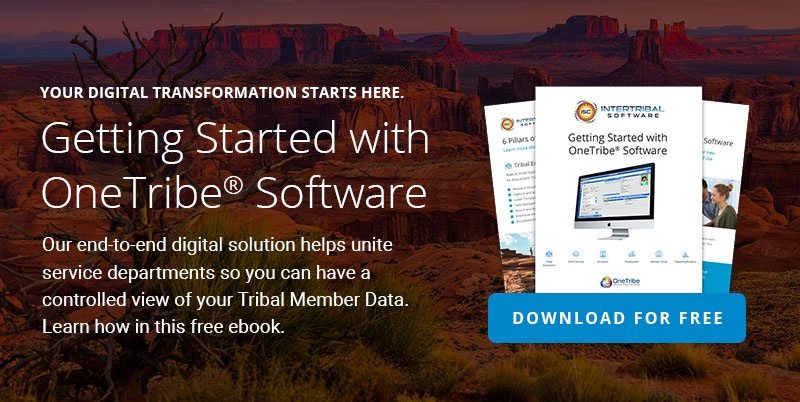
Some of the more prominent difficulties around implementing digital transformation aren’t what you might think. In fact, for the most part, a majority of the challenges that can hold up a comprehensive technology rollout are on the nontechnical side of things rather than getting caught in the weeds of a cloud solution.
From silos to a lack of appropriate change management processes, these all act as inhibitors to digital scaling. The right way to combat these objections is for a few key challenges to digital transformation and considerations in mind around the work culture of your tribal government, including training and adequate communication. Doing so will help you deliver great service to your members every time.
#1: Unify Teams and Decision Making
According to Gartner, 51% of respondents in their research pointed out “siloed strategies and decision making as a high-priority challenge” in their digital transformation rollouts. Getting your members on board with the benefits of going digital will get their buy-in and adoption rates will accelerate much faster than if you leave silos to be silos.
For an implementation, consider giving employees certain roles throughout the process so they feel they’re actively part of the improvements being made. Recognition also goes a long way, as these rollouts can be very lengthy and it’s easy to revert back to old habits.
#2: Train Leaders on Embracing Change
To truly strategize a long-term digital transformation strategy, upskilling your current leaders is vital to success. Do this in different departments so they understand why there might be a lingering resistance to adoption. Relating the initial purpose and reasoning behind the project and tying these to the business outcomes throughout the project will be a helpful digital transformation consideration.
#3: Tie Business Outcomes to ROI
For many digital systems, securing a budget can be a roadblock to achieving new technology. In order to get appropriate funding, directly tie your goals into the solution you’re looking for and how it will be more profitable and efficient once it’s running. Many times, with automation, this compounds over time with bots working on data entry and updates – all while minimizing or eliminating human error completely, so highlight those factors as part of your goals and why it ties into that growth and return on investment.
A digital transformation expert is a great resource to tie your desired metrics – they can also provide projections, case studies, or other instances on how your proposed tech will make a huge impact in all the right ways you’re looking for.
#4: Time Your Implementation Wisely
Another digital transformation consideration is around timing. It’s most definitely a marathon and not a race, but that doesn’t mean you can’t hold your government to specific deadlines. This will help keep everyone’s eye on the prize and functions as a great planning tool to check off one more task. This should be done in the initial strategy and planning phases so you’re able to factor in training, learning curves, and implementation over a large span of time. You’ll be checking this regularly and adjusting, of course, but having a plan around people is key to hitting realistic goals!
#5: Work With an Experienced Professional
Having guidance is one of the best things you can do during this process. Technology experts have vast acumen in all areas of implementations – including cloud, automation, and other systems – so you can trust the right provider will advise on what’s best for you. Being able to offer hands-on training or support for a period after implementation is also a great way to help drive adoption and help others adjust to the new system. It’s well worth the investment to speed the process along and help you avoid common pitfalls.
Digital Transformation Considerations for Success
No two digital transformation rollouts are ever the same – which is why it can be such a nuanced issue. The great thing is they’re very customizable and can be adjusted based on your current and future needs (always consider future needs!). To learn more about getting started in the world of digital transformation and software, be sure to read more about OneTribe™ software here.
Sign Up For Our Newsletter
Recent Posts
- Innovations in Housing: Revolutionizing Tribal Housing with Digital Tools for Management
- Empowering Tribal ICW Departments: Achieve ICWA Compliance and Certification Success with OneTribe® Software
- OneTribe CCA - Your Child Care Data Tracker Replacement Solution
- Transform Your Tribal Member Services With Integrated Software Solutions
- Intertribal Software Raises Strategic Investment
Categories
- OneTribe Software
- digital transformation
- tribal government software
- Laserfiche ECM
- Intertribal Software Consultants
- Childcare Assistance
- Housing Management
- Intertribal Software
- tribal member management
- AFCARS Data Collection
- Child Care Data Tracker
- Child Welfare
- Housing
- ICWA
- ICWA Compliance
- Indian Child Welfare Act
- OneTribe Platform
- Title IV-E Certification
- Tribal Data Tracker
- Tribal Family Services
- Tribal Housing
- Tribal ICWA Software

















